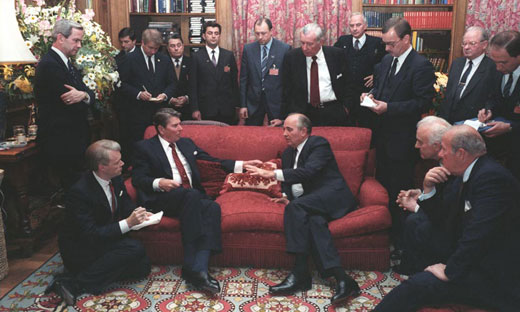
On this date 30 years ago in 1985, President Ronald Reagan stated that the Strategic Defense Initiative (SDI), intended only to destroy weapons, would not be part of negotiations on reducing offensive nuclear weapons in the upcoming talks with the Soviets in Geneva. The Soviets responded by stating that the U.S.was militarizing space.
The Strategic Defense Initiative (SDI) was a proposed missile defense system intended to protect the U.S. from attack by ballistic strategic nuclear weapons, both submarine-launched and intercontinental ballistic missiles (ICBMs). The system, which was to combine ground-based units and orbital deployment platforms, was first publicly announced by Reagan in 1983. The initiative focused on strategic defense rather than the prior doctrine of mutual assured destruction (MAD), which held that no power would use nuclear weapons knowing that the response would be mutual annihilation.
A vocal critic of MAD, Reagan used SDI as part of his defense policy to end MAD as a nuclear deterrence strategy, as well as to neutralize Soviet nuclear defenses.
The ambitious initiative was widely criticized as being unrealistic, even unscientific, as well as for threatening to destabilize MAD and re-ignite an offensive arms race. SDI was derided in the mainstream media as “Star Wars,” after the popular 1977 film by George Lucas. In 1987, the American Physical Society concluded that a global shield such as “Star Wars” was not only impossible with existing technology, but that ten more years of research was needed to learn whether it might ever be feasible.
Reagan’s March 23, 1983 “Star Wars” speech,coupled with his”Evil Empire” speech two weeks earlier, ushered in the final major escalation in Cold War rhetoric prior to a thawing of relations in the later 1980s.
The concept for the space-based portion of Reagan’s new defense policy was to use lasers to shoot down incoming Soviet ICBMs armed with nuclear warheads. Nobel Prize-winning physicist Hans Bethe went to Livermore in February 1983 for a two-day briefing on the X-ray laser and came away profoundly skeptical of its potential for national defense.
Frances Fitzgerald hypothesized that Reagan may have been inspired to create SDI by a fictional secret weapon, a ray that can paralyze electrical currents, in Murder in the Air, a movie he made in 1940.
As SDI was being floated during the years 1983-85, the Soviets not only recognized the program as a threat to the physical security of the Soviet Union, but also as an opportunity to weaken NATO. They saw that by advocating space-based missile defenses, the U.S.would make nuclear war inevitable, and that this strategy would introduce a wedge between the U.S. and its NATO allies concerned over European security and economic interests.
In 1986 the scientist Carl Sagan summarized what he heard Soviet commentators saying about SDI: On one hand, it was designed to start an economic war through a defensive arms race to further cripple the Soviet economy with extra military spending, and on the other, it served as a disguise for a United States intent on initiating a first strike on the Soviet Union.
Another criticism of SDI was that it would require the U.S. to modify previously ratified treaties. The Outer Space Treaty of 1967 required that”States Parties to the Treaty undertake not to place in orbit around the Earth any objects carrying nuclear weapons or any other kinds of weapons of mass destruction, install such weapons on celestial bodies, or station such weapons in outer space in any other manner.” The U.S. would thus be forbidden from pre-positioning in Earth orbit any devices powered by nuclear weapons and any devices capable of “mass destruction.”SDI’s space-stationed nuclear-pumped X-ray laser concept would have violated this treaty.
The Anti-Ballistic Missile Treaty and the Nuclear Non-Proliferation Treaty required that”Each of the Parties to the Treaty undertakes to pursue negotiations in good faith on effective measures relating to cessation of the nuclear arms race at an early date and to nuclear disarmament, and on a treaty on general and complete disarmament under strict and effective international control.”
Around the world, people living in every kind of social system viewed Reagan’s “Star Wars” strategy as a barbaric escalation and provocation.
Adapted from Wikipedia and other sources.
Photo: Wikipedia (CC)










